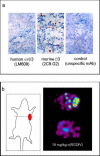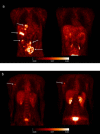Noninvasive visualization of the activated alphavbeta3 integrin in cancer patients by positron emission tomography and [18F]Galacto-RGD
- PMID: 15783258
- PMCID: PMC1069665
- DOI: 10.1371/journal.pmed.0020070
Noninvasive visualization of the activated alphavbeta3 integrin in cancer patients by positron emission tomography and [18F]Galacto-RGD
Abstract
Background: The integrin alphavbeta3 plays an important role in angiogenesis and tumor cell metastasis, and is currently being evaluated as a target for new therapeutic approaches. Several techniques are being studied to enable noninvasive determination of alphavbeta3 expression. We developed [(18)F]Galacto-RGD, a (18)F-labeled glycosylated alphavbeta3 antagonist, allowing monitoring of alphavbeta3 expression with positron emission tomography (PET).
Methods and findings: Here we show by quantitative analysis of images resulting from a small-animal PET scanner that uptake of [(18)F]Galacto-RGD in the tumor correlates with alphavbeta3 expression subsequently determined by Western blot analyses. Moreover, using the A431 human squamous cell carcinoma model we demonstrate that this approach is sensitive enough to visualize alphavbeta3 expression resulting exclusively from the tumor vasculature. Most important, this study shows, that [(18)F]Galacto-RGD with PET enables noninvasive quantitative assessment of the alphavbeta3 expression pattern on tumor and endothelial cells in patients with malignant tumors.
Conclusions: Molecular imaging with [(18)F]Galacto-RGD and PET can provide important information for planning and monitoring anti-angiogenic therapies targeting the alphavbeta3 integrins and can reveal the involvement and role of this integrin in metastatic and angiogenic processes in various diseases.
Conflict of interest statement
Figures




References
-
- Hood JD, Cheresh DA. Role of integrins in cell invasion and migration. Nat Rev Cancer. 2002;2:91–100. - PubMed
-
- Ruoslahti E. Specialization of tumour vasculature. Nat Rev Cancer. 2002;2:83–90. - PubMed
-
- Felding-Habermann B. Integrin adhesion receptors in tumor metastasis. Clin Exp Metastasis. 2003;20:203–213. - PubMed
-
- Brooks PC, Montgomery AM, Rosenfeld M, Reisfeld RA, Hu T, et al. Integrin alpha(v)beta 3 antagonists promote tumor regression by inducing apoptosis of angiogenic blood vessels. Cell. 1994;79:1157–1164. - PubMed
-
- Brooks PC, Clark RA, Cheresh DA. Requirement of vascular integrin alpha v beta 3 for angiogenesis. Science. 1994;264:569–571. - PubMed
Publication types
MeSH terms
Substances
LinkOut - more resources
Full Text Sources
Other Literature Sources

